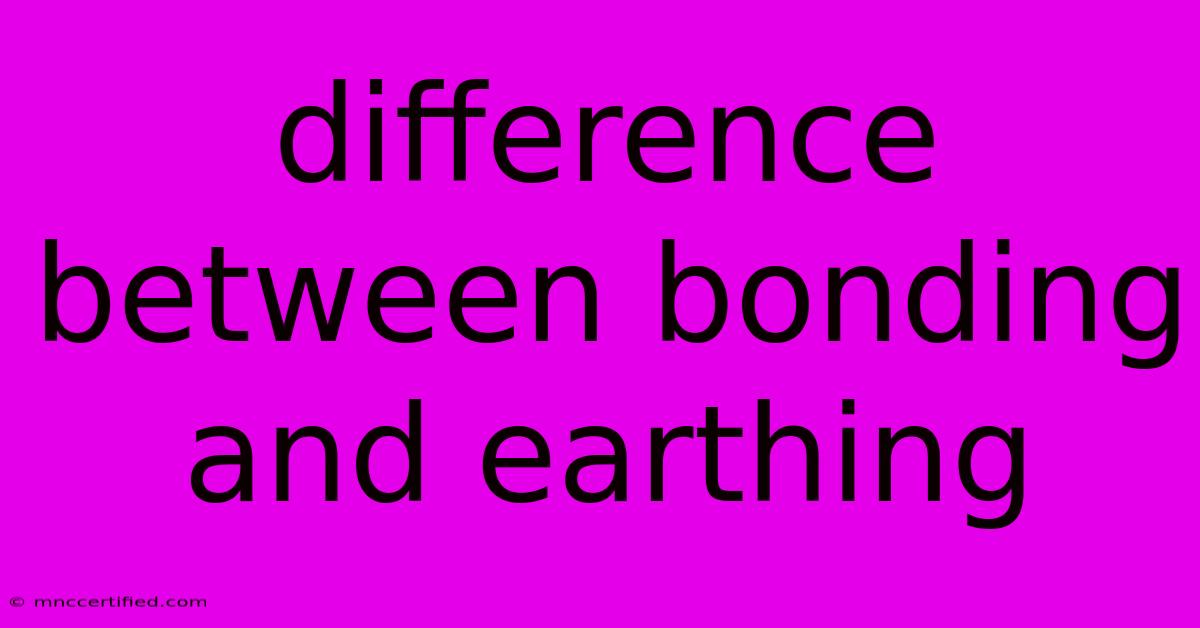Difference Between Bonding And Earthing

Table of Contents
Bonding vs Earthing: Understanding the Crucial Difference
In the world of electrical safety, the terms "bonding" and "earthing" are often used interchangeably, leading to confusion. While both play critical roles in protecting people and equipment from electrical hazards, they are distinct concepts. Understanding their differences is crucial for ensuring a safe and reliable electrical system.
What is Earthing?
Earthing, also known as grounding, is the process of providing a low-resistance path for electrical current to flow from a conductive object to the earth. This path is typically provided by a grounding electrode buried in the soil. The primary purpose of earthing is to:
- Protect against electrical shocks: If a fault occurs and a live wire comes into contact with a conductive surface like a metal appliance, earthing ensures that the current flows to the earth instead of through a person touching the appliance. This prevents electrocution.
- Protect against overvoltages: Earthing can dissipate surges of electricity caused by lightning strikes or other power fluctuations, protecting equipment from damage.
What is Bonding?
Bonding, on the other hand, involves connecting all conductive parts of an electrical system together. This creates a common electrical potential throughout the system, minimizing the risk of voltage differences between connected components. The main objectives of bonding include:
- Eliminating voltage differences: Bonding ensures that all metallic parts in an electrical system are at the same electrical potential, preventing dangerous voltage differentials that can cause arcing or sparking.
- Providing a path for fault currents: In case of a fault, bonding allows fault currents to flow through the interconnected system, minimizing the risk of shocks and equipment damage.
Key Differences Between Bonding and Earthing
Here's a table highlighting the key differences between bonding and earthing:
| Feature | Earthing | Bonding |
|---|---|---|
| Purpose | Provide a path to the ground | Connect conductive parts together |
| Connection | To ground electrode | Between conductive parts |
| Primary objective | Safety against electrical shocks and overvoltages | Eliminate voltage differences and provide a path for fault currents |
| Typical applications | Electrical appliances, grounding rods, electrical systems | Metal conduits, enclosures, equipment frames |
Importance of Both Bonding and Earthing
Both bonding and earthing are essential for maintaining a safe and reliable electrical system. They work together to minimize the risk of electrical hazards.
- Earthing provides a path for fault currents to flow to the ground, preventing electric shocks.
- Bonding ensures that all conductive parts are at the same electrical potential, minimizing the risk of voltage differentials and arcing.
Conclusion
While often confused, bonding and earthing are distinct concepts with different but equally important roles in electrical safety. Understanding their differences is crucial for ensuring a safe and reliable electrical system. Both are integral components of a comprehensive electrical safety strategy, working in tandem to mitigate risks and protect people and equipment from electrical hazards.

Thank you for visiting our website wich cover about Difference Between Bonding And Earthing. We hope the information provided has been useful to you. Feel free to contact us if you have any questions or need further assistance. See you next time and dont miss to bookmark.
Featured Posts
-
Crypto Reels 100 No Deposit Bonus 2023
Nov 08, 2024
-
German Government Collapse Why Now
Nov 08, 2024
-
Business Insurance Top 100 Brokers 2023
Nov 08, 2024
-
Does My Insurance Cover Physical Therapy
Nov 08, 2024
-
Private Flood Insurance Lloyds Of London
Nov 08, 2024